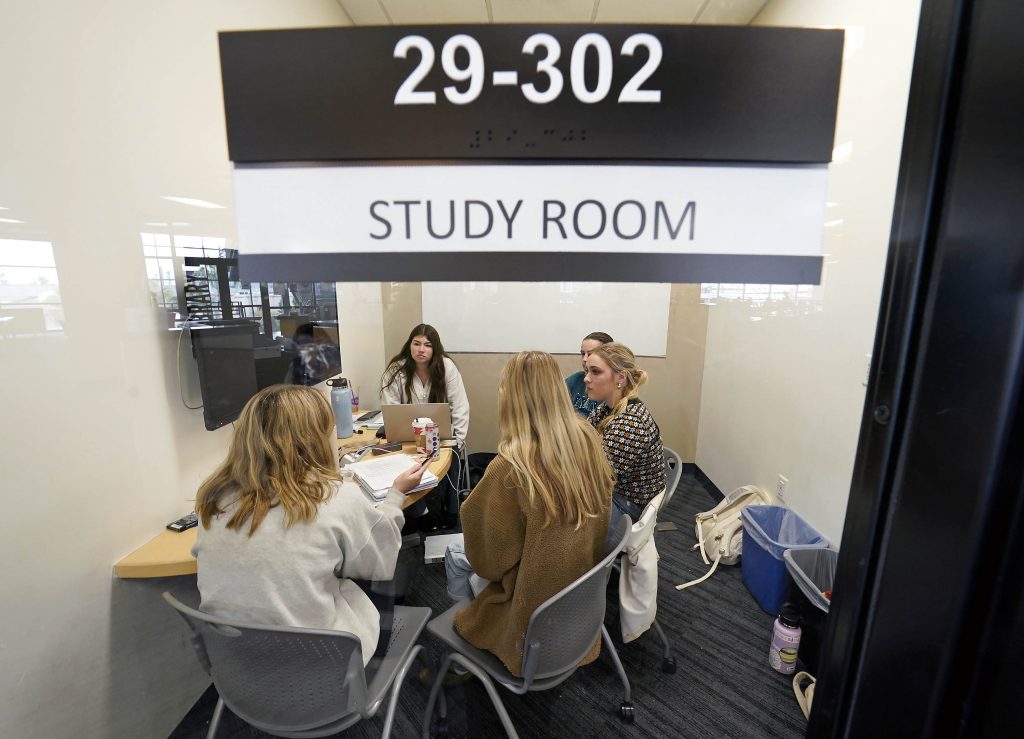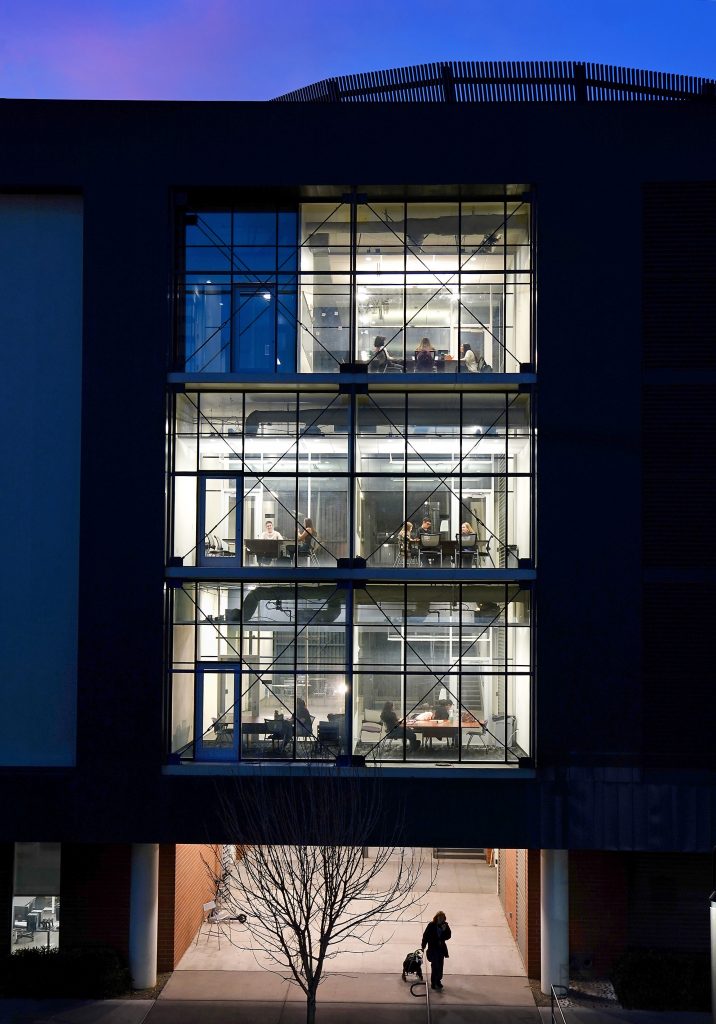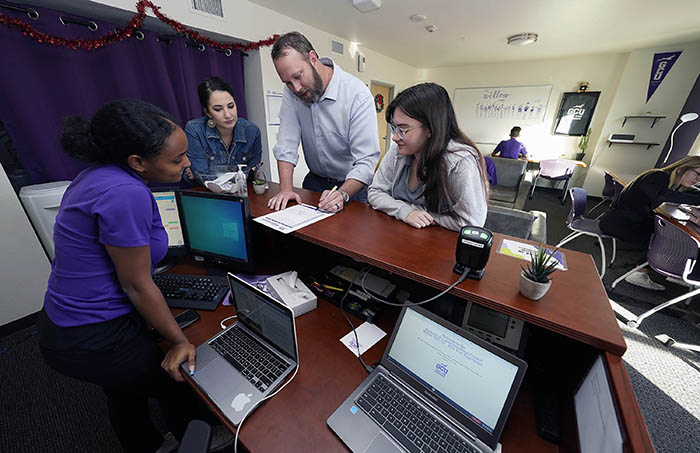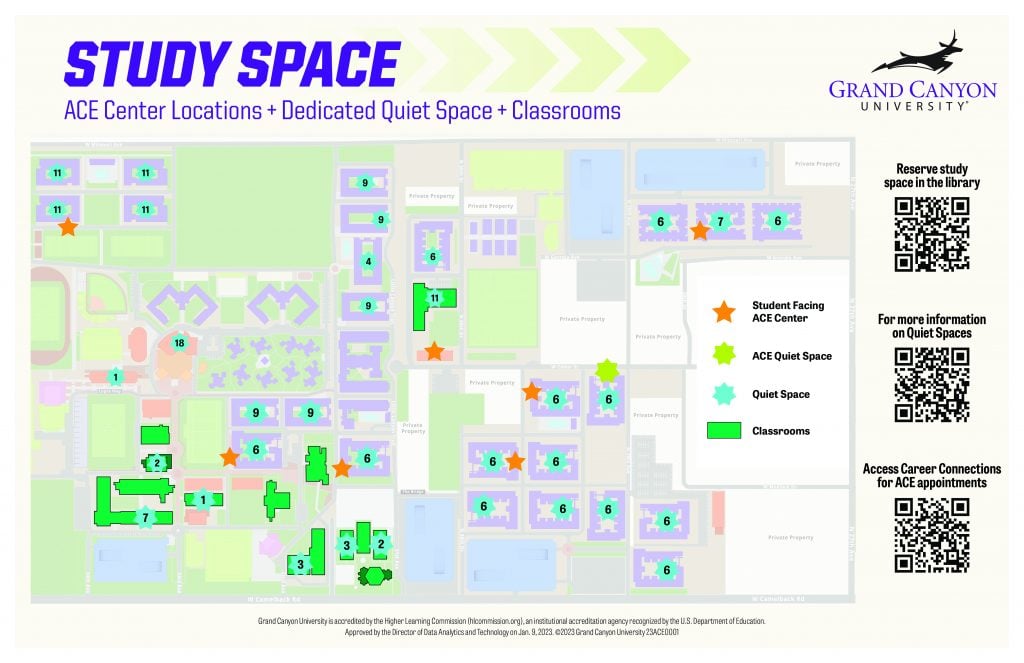
Photos by Ralph Freso
Junior nursing student Eden Anderson likes to nestle into a study room on one of the top floors of Grand Canyon University’s Colangelo College of Business. The fishbowl-like space comes complete with a whiteboard. It's the perfect bookworm place of study escape.
Unless it’s exam go-time.
“If you’re trying to go hard on an assignment, I go to the library when I really want to laser in on something,” said Anderson, though as the day was winding down on Tuesday, she nabbed a table in the corner of the Student Union's North Dining Hall with a group of five other nursing students. They delved into their notes from their notoriously challenging med-surge (medical-surgical) class as the hustle and bustle of dining room chatter filled the room.

Wherever Anderson likes to study, whether it’s an ultra-quiet space for high-focus scenarios or one with a little background noise to help keep her alert, there’s a study space for her on campus.
To be a little more precise, there are more than 240 dedicated quiet spaces on campus — rooms designated for studying that go beyond the four walls of students’ residence hall rooms.
That number doesn’t include all the nondesignated areas conducive to study, such as the tables that pepper the hallways outside of classrooms in various college buildings, or outdoor seating areas, such as the one near the Lope Shop or outside Kaibab, or the bevy of grassy spaces that invite students to study in the sunny Arizona outdoors.
“You have these places to go study, obviously GCBC, the library — those are great places,” said Willy Lange, Director of Academic Analytics and Technology. “But sometimes you want to change the scenery up or you want to see something different.
“If you don’t want to be in your dorm room but still be in your dorm, they (the residence halls) have rooms on each floor where students can go in and study.”
The norm is at least one quiet room per floor, though the quartet of freshmen residence halls at The Grove — that’s Acacia, Ironwood, Juniper and Willow — each tout 11 quiet spaces on their six floors.
Besides the residence halls, other stellar venues to do all the cognitive thinking students need to do are the Academic and Career Excellence Centers.

The campus' seven ACE Centers are widely known as the places on campus students can go when they need academic help from learning advocates, or LEADs. But, outside of those 240 or so dedicated study rooms, they are also prime places to study.
One thing students might be surprised to learn is that classrooms can be used as study spaces if they're not in use, though they might not be open as late as the designated quiet spaces.
They might be surprised to learn, too, that the library, once upon a time one of the only quiet places to study on any school campus, is still a popular choice when it comes to becoming one with the books, notes and all things academia. If you ask students where they go study, they'll say the library or its neighbor in the Student Union, student coffee shop GCBC.
"It's funny, because it's such a different environment. We're very quiet and that's not ever intentional," the library's Access Service Manager, Kelly O'Neill, said of students who respect libraries as the place to go if you need a quiet spot to think. "... Then on the second floor (at GCBC), there's music, it's crowded and there's talking. We're more of a quiet, calm space. ... It's a good study vibe," said O'Neill.

The GCU Library touts 18 quiet spaces, the most of any building on campus, with 10 rooms on the third floor and eight on the fourth floor. They seat four to five people and can be reserved online in 30-minute to four-hour blocks. They come with dry eraser boards and screens so students can display what's on their computer on those screens.
Those study rooms in the library fill up quickly, so O'Neill said, "We like to direct students to the other (study) spaces on campus."
She spent time last year taking photos of the campus' quiet spaces so students can see what they look like and choose where they might want to study.
Flyers that map out those designated spaces are peppered around campus. They include QR codes that take students to websites to reserve a library study room, access Career Connections for ACE Center appointments, or get more information on quiet spaces (complete with those pictures of study rooms).
It isn’t all the campus is doing to promote GCU’s study culture.
Lange said these designated spaces are first-come, first-serve and that campus leaders are looking at ways to improve how students will know whether or not a certain study room is already being used.
| Some helpful links: |
| FOR MORE INFORMATION ON QUIET SPACES: https://libguides.gcu.edu/StudySpaces |
| RESERVE STUDY SPACE IN LIBRARY: https://libcal.gcu.edu/reserve/StudyRooms |
| ACCESS CAREER CONNECTIONS FOR ACE APPOINTMENTS: https://gcu-csm.symplicity.com/ |
And the branding of these quiet spaces continues to evolve.
“There are some students that won’t leave their dorm, and that’s OK. That works for them,” Lange said. “But there are some that need the hustle and bustle of GCBC. They like that energy. There are others that need an ACE Center where there’s a LEAD right next to them.”
Whatever conditions work best for them, a study space is there to meet those needs.
“Our hope is to really get the word out,” Lange said. “… It’s been a collaborative effort with all departments and colleges to really figure out how to support students.”
Ultimately, Lange added, “We want to make it more convenient for students to study in the area that works best for them.”
Lana Sweeten-Shults, Manager of Internal Communications, can be reached at [email protected] or at 602-639-7901.
***
Related content:
GCU News: ACE Centers again offer in-person academic support
GCU News: GCU program helps new students find guiding lights
















